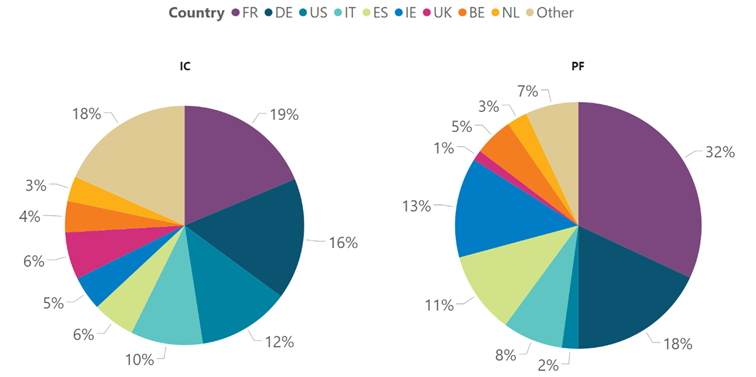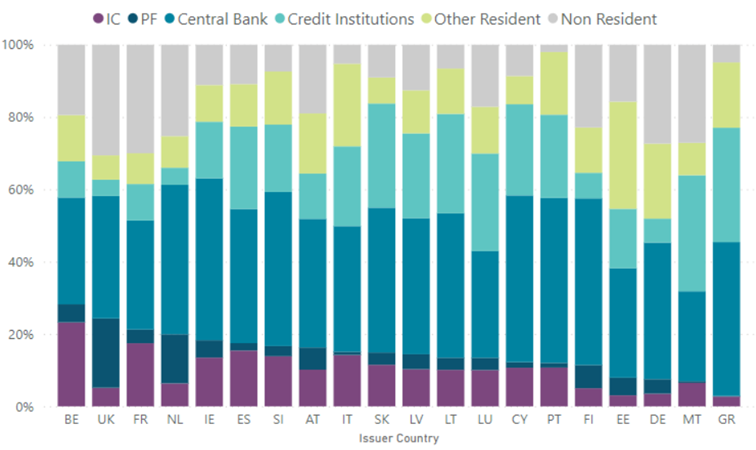Behind the Data

The Insurance & Pension - Sovereign Nexus
Mark Mulholland *
July 2023
Euro area – rather than domestic – debt makes up the bulk of direct sovereign holdings by the Irish ICPF sector. While this domestic sector has diminished in importance as a holder of Irish sovereign debt, euro area ICPFs have become significant investors, highlighting the importance of further understanding the role of this broad sector in the market.
Introduction
While growth in the domestic economy this year is expected to be slightly stronger than previously expected, there have been a number of challenges to the economic environment since early 2022 (Quarterly Bulletin, Q2 2023). In particular, the recent period of inflation and rising interest rates has led to significant market volatility as vulnerabilities built up in segments of the global financial system have been exposed (Financial Stability Review, H1 2023).
As insurance corporation and pension fund (ICPF) liabilities are often based on long-term entitlements due in the future, these sectors have traditionally been considered to have stabilising effects on markets during periods of instability as they can usually maintain assets despite short term fluctuations in prices. However, in certain circumstances, these sectors (and specifically, concentrations in behaviour at firm level combined with significant sectoral market holdings) could negatively impact the real economy by amplifying existing vulnerabilities and causing spillovers across markets. The recent disruption in the UK gilt market is a prime example, with the use of leveraged liability driven investment (LDI) strategies by defined benefit pension funds, through direct and indirect holdings, contributing towards deteriorating market liquidity and a spike in gilt yields (Pinter, 2023). This episode had significant and persistent adverse spillovers for other market participants and the broader UK economy.
In addition to firm level oversight, this episode shows the importance of understanding macro-financial interlinkages and in particular the links between the ICPF sector and sovereign debt markets, given current market volatility. The global financial and euro area sovereign debt crises have previously highlighted the importance of the sovereign-bank nexus – that is, how these sectors are intertwined (see Guerrero, Metzler & Scopelliti (2020) and Dell’Ariccia et al. (2018)). To explore potential exposures between the ICPF sector and sovereign debt markets, this Behind the Data (BTD) draws on the Central Bank’s granular financial sector datasets and provides an initial look into the diversification of domestic ICPF sovereign debt holdings, how the importance of this sector in the context of the overall Irish sovereign debt market has changed over time and, lastly, how the concentration of sovereign debt holdings compares across the UK and euro area countries.
The Data
This BTD combines IC and PF statistical data submitted to the Central Bank of Ireland, with securities holdings and issuance statistics, to explore the degree of interconnectedness between ICPF sectors and sovereign debt markets. Previous work has already explored the international nature of PF debt security holdings and interconnectedness between the IC sector and investment funds. The granularity of these statistics facilitates a novel in-depth insight into the holdings of the sector at home and, by introducing comparable data from both the euro area and UK, a cross-country comparison. The harmonised nature of these data allow us to place the domestic sector as a benchmark and to better understand how these globally active non-bank financial intermediaries compare at a granular level.
Irish ICPFs have diversified holdings of euro area sovereign debt
The Irish ICPF sector, including internationally focused ICs, is a large institutional investor with combined total assets standing at over €530 billion in Q1 2023 with ICs accounting for €405 billion and PFs €128 billion. Of this, directly-held sovereign debt accounts for €50 billion, or 9.5% of total assets. This is made up of €41.7 billion in the IC sector and €8.6 billion in the PF sector.
Both sectors have a relatively diversified portfolio of direct sovereign debt holdings across countries (Chart 1). For PFs, 94% is concentrated within euro area countries, while this figure is 69% for ICs. French sovereign debt makes up the largest proportion for both the IC (19%) and PF (32%) sector. A comparable level of domestic and UK gilts are held for IC (5-6%) while PFs have far more Irish holdings (13%) than UK (1%). While these findings show the direct exposure of the sector to Irish sovereign debt is relatively less than to other sovereigns, their sovereign debt portfolios could potentially be exposed to a common shock across euro area markets.
Chart 1: Irish IC and PF sectors composition of sovereign debt portfolio by issuer country (Q1 2023)

Source: Central Bank of Ireland IC and PF Statistics
Importance of Irish ICPFs in domestic sovereign debt has fallen
The Irish ICPF sector has historically been a significant player in the Irish sovereign debt market with the share held by the sector peaking at 47% in 1998 (Chart 2). With Ireland’s transition to the euro, the non-resident sector grew while the Irish resident sectors share of holdings declined. This may have been driven, in part, by the opportunity for diversification of euro denominated debt, which is mirrored in the holdings of the Irish ICPF sector today. The degree of Irish ICPF holdings has decreased in recent years to less than 2% of total outstanding Irish issued sovereign debt in 2022, with domestic holders consisting almost entirely of credit institutions and central bank. By comparison, the UK debt management office distribution of gilt holdings data shows the UK ICPF sector holdings of UK gilts is 24% of the entire market, as of Q4 2022. Such concentrations in the market for gilts – together with underlying vulnerabilities due to the use of leverage through LDI strategies – may have contributed towards triggering market instability in the UK in late 2022 (UK Industry and Regulators Committee) with selling pressure in long-dated conventional gilts and index-linked gilts leading to evaporating market liquidity (Pinter, 2023).
Chart 2: Sectoral holdings of Irish sovereign debt since 1987

Source: Central Bank of Ireland Long Term Government Debt Holdings
Note: Nominal values
There is evidence within the sovereign debt portfolio of the Irish PF sector of a preference for index (inflation) linked debt. Such bonds can help to hedge against inflation risk because the coupons are linked to an inflation index. Of the €8.6 billion held by pension funds, 35% is index linked, a considerable proportion given the wider euro area sovereign debt markets consists of only 6% index linked. This may reflect a desire to align assets and liabilities, in particular inflation linked liabilities, such as some defined benefit pension entitlements. This could also partly explain the relative preference for French sovereign debt, which is among the largest euro area index linked markets. While ICs also hold a large portfolio of index linked sovereign debt, this is not held to any greater extent than might be expected given the composition of the wider euro area market.
Euro area ICPF sectors are significant investors in Irish sovereign debt
Given the connections that have developed since the introduction of the euro, the view of holdings can be expanded using ECB and UK data to capture all euro area and UK resident sector ICPF holdings. Chart 3 shows a percentage breakdown of holdings of issuer country sovereign debt by resident and non-resident sectors. Resident is defined as all euro area for euro area countries and UK only for UK.
Comparing across a range of issuer countries, the ICPF share of holdings ranges from a low of 3% to a high of 28%. The most prominent ICPF sector holding is in the Belgian market, followed by the UK (24%). This data shows the euro area ICPF sector is a significant player in the Irish sovereign debt market, holding 18% of Irish sovereign debt. EIOPA data shows that as of Q4 2022, the German (€4.7 billion), French (€3.6 billion) and Italian (€3.4 billion) IC sectors, as well as the Dutch PF sector (€3.7 billion) are among the key holders of Irish sovereign debt.
With the split between the IC and PF sectors, it is clear that in Ireland, and most other euro area countries, the IC sector is more significant than the PF sector. This contrasts with the UK, where an estimated 80% of ICPF holdings are with the PF sector, highlighting the sectoral gilt market concentration which may have contributed to the recently experienced volatility. Only the Dutch PF sector is comparable, accounting for 68% of the overall ICPF sector’s holdings in the Netherlands. While this data shows the extent of the role of the ICPF sector in sovereign debt markets, the degree of any concentrations in investment and risk management strategies, or the use of leverage, would be key determinants of the sectors’ potential to amplify market volatility, which are beyond the scope of this note.
Chart 3: Sectoral holdings of sovereign debt by issuer country (Q1 2023)

Source: European Central Bank Securities Holdings (SHSS) and Issues (CSEC) Statistics, UK Debt Management Office Gilt Holdings Statistics
Notes: Market values. Euro area data: non-resident (i.e. non euro area) implied from total economy issuance (CSEC) less resident (i.e. euro area) total economy holdings (SHSS). UK data: Q4 2022 data, author’s own calculation of UK IC and PF estimated split of total ICPF holdings using Office for National Statistics FSPS and Bank of England insurance aggregate data. UK resident holdings are UK resident sectors only. UK credit institutions data relates to MFIs excluding Central Bank.
Conclusion
Given the recent disruption in the UK gilt market that was amplified by the ICPF sovereign nexus, these sectors have become an area of focus due to the potential for adverse spillovers causing volatility across economic markets. Drawing on the Central Bank’s granular financial sector data and securities statistics, this BTD investigates potential direct links between Irish sovereign debt and the ICPF sector. It shows that the domestic ICPF sector has relatively diversified sovereign debt holdings, predominantly across euro area countries. The overall importance of the sector relative to domestic debt has diminished in recent years as the credit institution and central bank and non-resident sectors increased market share. However, large euro area ICPF sectors, such as Germany and the Netherlands, have become significant investors in Irish sovereign debt. All of which could represent a diversification of risk for Irish ICPFs and the domestic sovereign debt market. However, potential risk channels from international markets require continued monitoring.
This BTD highlights the importance of better understanding domestic and foreign ICPF sectors due to the scale and variation of their sovereign debt investments. As the economic environment continues to develop, the pattern of sovereign debt holdings relative to supply, particularly amongst central banks, banks and ICPFs may warrant further attention. Such market risks remain at a high level and related vulnerabilities are an important area of focus for policy makers and regulators of the ICPF sector. Analysis of the investment behaviour of the ICPF sector, including indirect exposures to sovereign markets across the economic cycle and deeper insight into segments of the sovereign debt market, will help to further understand the role of this sector in the wider market.
*Email [email protected] if you have any comments or questions on this note. Comments from Kenneth Devine, Jenny Osborne-Kinch, Maria Woods, Jean Cassidy, Robert Kelly, Barra McCarthy and Vasileios Madouros are gratefully acknowledged. Thank you to Raymond O’Sullivan for assistance with IC data and colleagues in the Securities Statistics team for their assistance with securities holdings data. The views expressed in this note are those of the author and do not necessarily reflect the views of the Central Bank of Ireland or the ESCB.
See also: